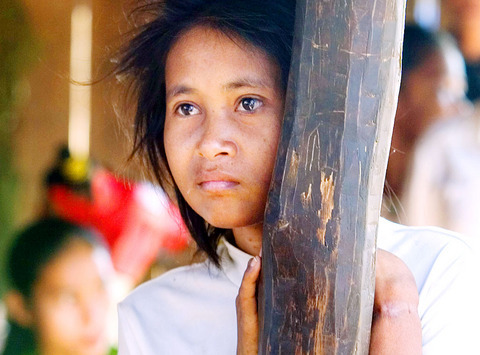She sits for hours at a time, staring at the floor or at the throngs of villagers that have mobbed this small shack, her unsmiling face betraying nothing other than occasional fear flashing in her eyes.
Human rights groups fear that Cambodia's "jungle woman" is suffering from the spotlight cast on her since she emerged from the wild, and yesterday offered to provide medical and psychiatric treatment if requested.
A family claims the woman is Rochom P'ngieng, 27, who disappeared in the jungle of Cambodia's northeastern Rattanakiri Province while herding water buffaloes when she was eight years old.

PHOTO: AP
The family claims she is their long lost daughter, based on a scar on her right arm from an accident that occurred before her disappearance from the remote village of Oyadao.
"I dare anyone to wager 10,000 dollars if they think she is not my daughter," challenged Sal Lou, a policeman in this isolated village who said he immediately recognised his child by an old scar when she was brought naked and dirty from the jungle 10 days ago.
Sal Lou has said he is willing to undergo DNA testing along with the woman "to clear any doubts that she is my child."
Their hut has drawn crowds of villagers and journalists, keen to see the woman whose family says she was found on Jan. 13 walking like a monkey out of the jungle. She pats her stomach when hungry and uses animal-like grunts to communicate.
Since being taken to Oyadao, the woman has tried three times to escape back into the jungle, tearing at the dirty white blouse and patterned skirt her would-be parents dressed her in.
"Over the weekend she acted crazy -- she was scared of the crowds and the journalists trying to take pictures of her," said Rochom Ly, 27-year-old Rochom P'ngieng's younger brother.
Scores of people have come to watch her, milling around Sal Lou's ramshackle house, staring silently at the woman as she sleeps, sits squatting against the wall or is spoon-fed by Rochom Soy, Sal Lou's wife.
Many have begun to question Sal Lou's story.
How, they ask, could a woman from the jungle have such smooth hands?
If she had been truly wild, they ask, why are her fingernails neatly trimmed and her hair not a matted tangle?
Licadho, a non-governmental human rights group, fears the woman is enduring trauma after returning to society and could have been a victim of abuse, said Kek Galabru, the group's president.
"We believe that this woman is a victim of some kind of torture, maybe sexual or physical," she said. Licadho has offered to pay travel expenses to bring the woman and the family to Phnom Penh, about 400km away, and to provide housing costs while she undergoes treatment in the capital.
Penn Bunna, an official at Adhoc, another Cambodian human rights group, says the constant flock of visitors is likely causing new stress for the woman.
Adhoc has also offered to help fund psychiatric treatment.
"She must have experienced traumatic events in the jungle that have affected her ability to speak," he said.
Since the woman is unable to speak, her identity remains unclear with many questioning if she is indeed Rochom P'ngieng.
"I am doubtful that she went missing 19 years ago. I came here to see what she looked like, and she looks normal like us," said Dub Thol, who travelled from a neighbouring district to see the woman.
The woman has offered up no clues as to how she spent the past nearly two decades, communicating only her most basic needs with simple gestures.
Sal Lou said that despite not speaking, she has begun to understand his own hill tribe language of Phnong.
"When we talk to her she understands, but she cannot reply to us. This is because she has forgotten the language, she has not spoken it for a long time," he said.
"She follows what we tell her to do. When we tell her to sit, she sits," he said.
"So, sooner or later, she will know how to speak," he said.

China yesterday held a low-key memorial ceremony for the 1937 Nanjing Massacre, with Chinese President Xi Jinping (習近平) not attending, despite a diplomatic crisis between Beijing and Tokyo over Taiwan. Beijing has raged at Tokyo since Japanese Prime Minister Sanae Takaichi last month said that a hypothetical Chinese attack on Taiwan could trigger a military response from Japan. China and Japan have long sparred over their painful history. China consistently reminds its people of the 1937 Nanjing Massacre, in which it says Japanese troops killed 300,000 people in what was then its capital. A post-World War II Allied tribunal put the death toll

‘NO AMNESTY’: Tens of thousands of people joined the rally against a bill that would slash the former president’s prison term; President Lula has said he would veto the bill Tens of thousands of Brazilians on Sunday demonstrated against a bill that advanced in Congress this week that would reduce the time former president Jair Bolsonaro spends behind bars following his sentence of more than 27 years for attempting a coup. Protests took place in the capital, Brasilia, and in other major cities across the nation, including Sao Paulo, Florianopolis, Salvador and Recife. On Copacabana’s boardwalk in Rio de Janeiro, crowds composed of left-wing voters chanted “No amnesty” and “Out with Hugo Motta,” a reference to the speaker of the lower house, which approved the bill on Wednesday last week. It is

FALLEN: The nine soldiers who were killed while carrying out combat and engineering tasks in Russia were given the title of Hero of the Democratic People’s Republic of Korea North Korean leader Kim Jong-un attended a welcoming ceremony for an army engineering unit that had returned home after carrying out duties in Russia, North Korean state media KCNA reported on Saturday. In a speech carried by KCNA, Kim praised officers and soldiers of the 528th Regiment of Engineers of the Korean People’s Army (KPA) for “heroic” conduct and “mass heroism” in fulfilling orders issued by the ruling Workers’ Party of Korea during a 120-day overseas deployment. Video footage released by North Korea showed uniformed soldiers disembarking from an aircraft, Kim hugging a soldier seated in a wheelchair, and soldiers and officials

Cozy knits, sparkly bobbles and Santa hats were all the canine rage on Sunday, as hundreds of sausage dogs and their owners converged on central London for an annual parade and get-together. The dachshunds’ gathering in London’s Hyde Park came after a previous “Sausage Walk” planned for Halloween had to be postponed, because it had become so popular organizers needed to apply for an events licence. “It was going to be too much fun so they canceled it,” laughed Nicky Bailey, the owner of three sausage dogs: Una and her two 19-week-old puppies Ember and Finnegan, wearing matching red coats and silver